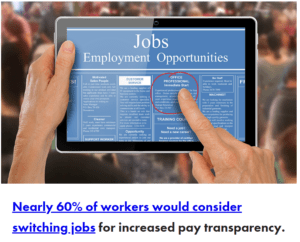With remote work increasing, is a location-based or value-based pay policy better?
By Emily Connery
Over 70% of employers lack a formal method to determine compensation for their remote workforce. Yet, how an organization chooses to pay its remote employees can leave a lasting impact on company culture and employee retention.
Businesses may find location-based salaries enticing because they can keep wages competitive and cost-effective. However, location-based pay may increase turnover if employees feel penalized for living in a more affordable location. Employees in the same roles experience location-based pay disparities ranging from 3% for entry-level associates to as high as 90% for software engineering roles.
As employees look for remote opportunities while remaining concerned about the current economy, employers face additional challenges with how to structure their compensation strategies to attract and retain talent. Instead of basing pay on location, some businesses may calculate remote salaries based on the value of their employees’ work and experience. Choosing the right strategy requires research and a commitment to transparency.
Leaders should consider several factors when determining whether to base their remote employees’ salaries on location or value.
Location-Based Salaries
Companies using a location-based salary policy make salary decisions based on where a remote employee lives, adding local tax rates and the cost of living into their salary calculations. This strategy offers employees in the same position similar take-home pay (their pay after expenses) and empowers businesses to set attractive, competitive wages without paying the highest rates across all markets.
During the complex process of determining location-based salaries, businesses must consider several factors:
- Experience. The education, skills, and length of time employees have spent in their current or similar positions.
- Market rates. The pay range for a specific role locally or nationwide.
- Cost of living index. A measure of an area’s core expenses, including housing, transportation, utilities, and meals.
- Income tax rates. A calculation most beneficial for international employees living in countries with exceptionally high tax rates. Because each state’s progressive structuring differs, calculating U.S. salaries based on income tax rates is rarely worth the effort.
How these four factors work together depends on each company’s values and capabilities. Some companies may only consider market rates and experience because they lack the time and resources to evaluate the other two variables. Other companies may have larger HR and accounting teams able to consider data from all four categories.
Companies must also devise a plan for adjusting compensation if a remote employee moves. An organization may update — and reduce — an employee’s salary based on the cost of living in a new place. Many big tech firms, like Meta, Amazon, and Microsoft, already do this. However, this policy demoralizes employees who see themselves penalized financially for opting to move to less expensive areas. Businesses using a value-based compensation plan avoid this scenario.
Value-Based Salaries
A value-based salary policy offers equal pay for equal work, regardless of geography. Companies using this strategy believe that as long as an employee proves they can be effective in a remote environment, their location shouldn’t matter.
This model is most popular among workers. In fact, more than 90% of employees believe organizations should determine salaries based on skill set and not their location. Value-based compensation gives employees more financial autonomy because pay changes based on skills, experience, and professional development are all aspects an employee can control.
This strategy also makes it easier for organizations to calculate salaries because their leadership must only consider two factors: national market rate and experience.
Calculating the average national rate for a specific role keeps jobs competitive. However, if a company’s pay drops below the average rates, it may struggle to retain talent. To minimize that risk, an organization should keep its salaries within the top 25% of salary rates.
Organizations can start by pinpointing the average national rate for a position and adjusting the base rate by calculating additional value according to experience. For example, the average national base salary for a remote project coordinator is $65,000. A company seeking a project coordinator with between one and five years of experience will offer a lower salary than a company expecting its new hire to have at least 10 years of experience. To attract and retain talent, businesses should pay higher than the national market rate when seeking employees with greater than average knowledge and skills.
Because experience is the only pay differentiator for remote employees in the same role, organizations must develop an objective system for evaluation. For example, a company can use a people analytics platform to create levels for each role type with clear, concrete criteria and set salary bands for each level. Managers evaluate an employee’s ownership of their role, impact, and leadership ability, using that data to promote an employee to the next level.
Implementing a defined system with objective benchmarks and salary bands minimizes the possibility of salary and raise biases. Benchmarks provide clarification about how an organization calculates salaries and inspires confidence among employees that an organization will not pay them less purely because of their race, sexual orientation, or gender.
Establish Salary Transparency
No matter the compensation strategy for remote workforces, leaders must remain transparent about their approach. Transparency correlates strongly with overall employee happiness and engagement. When remote employees lack context and clarity — especially about salaries — they can feel out of the loop.
Not only does salary transparency help with employee engagement, but it sets total compensation expectations, signaling that an organization cares about creating a fair and inclusive culture. In fact, nearly 60% of workers would consider switching jobs for increased pay transparency.
Organizations have many options for communicating compensation strategy changes to employees. They can make pay bands visible internally on a people analytics platform and share the process for salary review and updates, including how leaders decide wages beyond location and experience.
Transparency drives accountability. These approaches support fair and equal pay for employees. Empowering all employees to compare salary bands across roles and departments and clearly defining expectations for employees striving toward development and growth cultivates trust between a company’s leadership and employees.
How an organization chooses to pay remote workers has a lasting impact on company culture. When compensation policies associated with remote pay change, companies must communicate those updates to all employees. Transparency sets clear compensation expectations, which helps employees plan for the future.
Emily Connery is former VP of People and Talent at ChartHop.
















